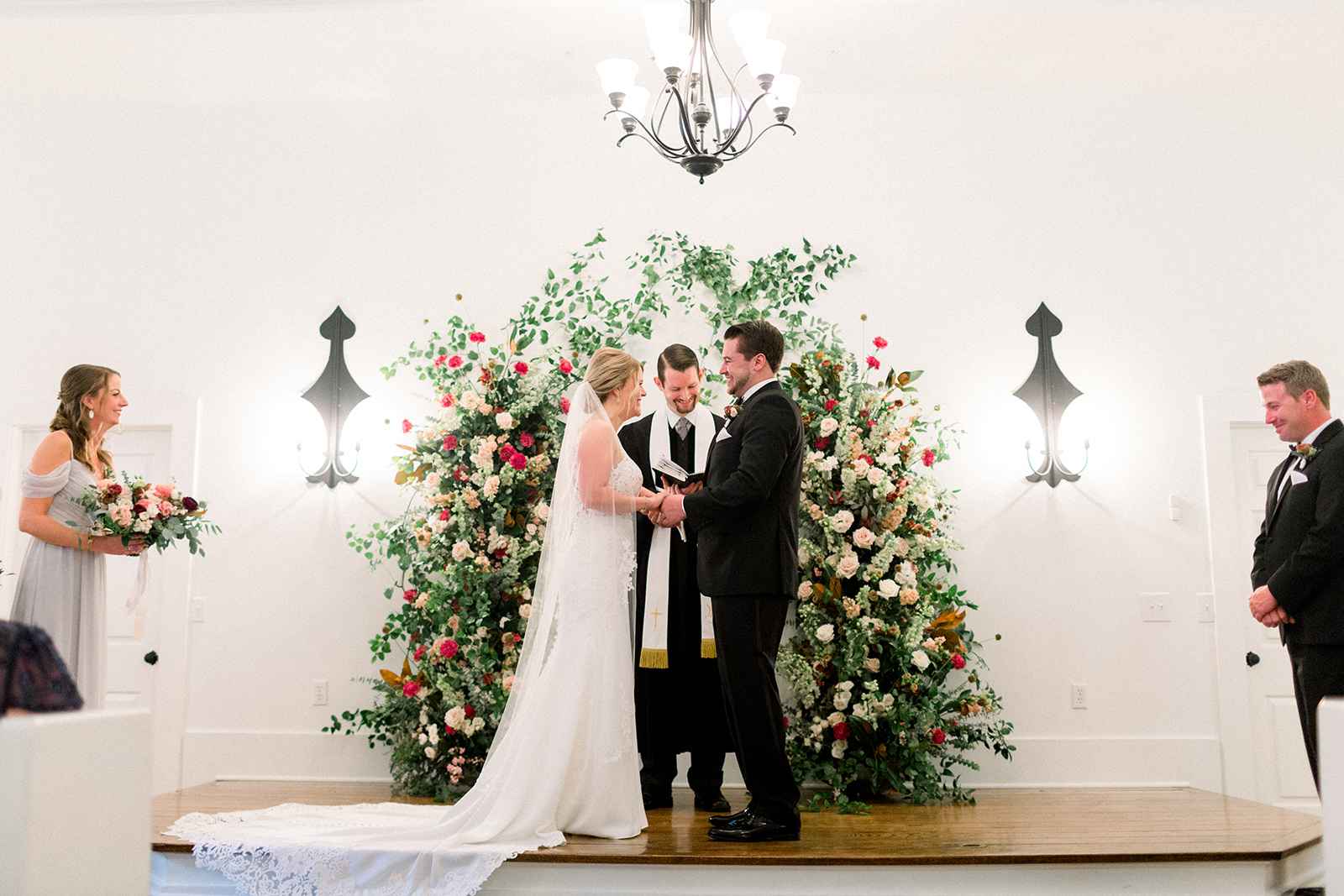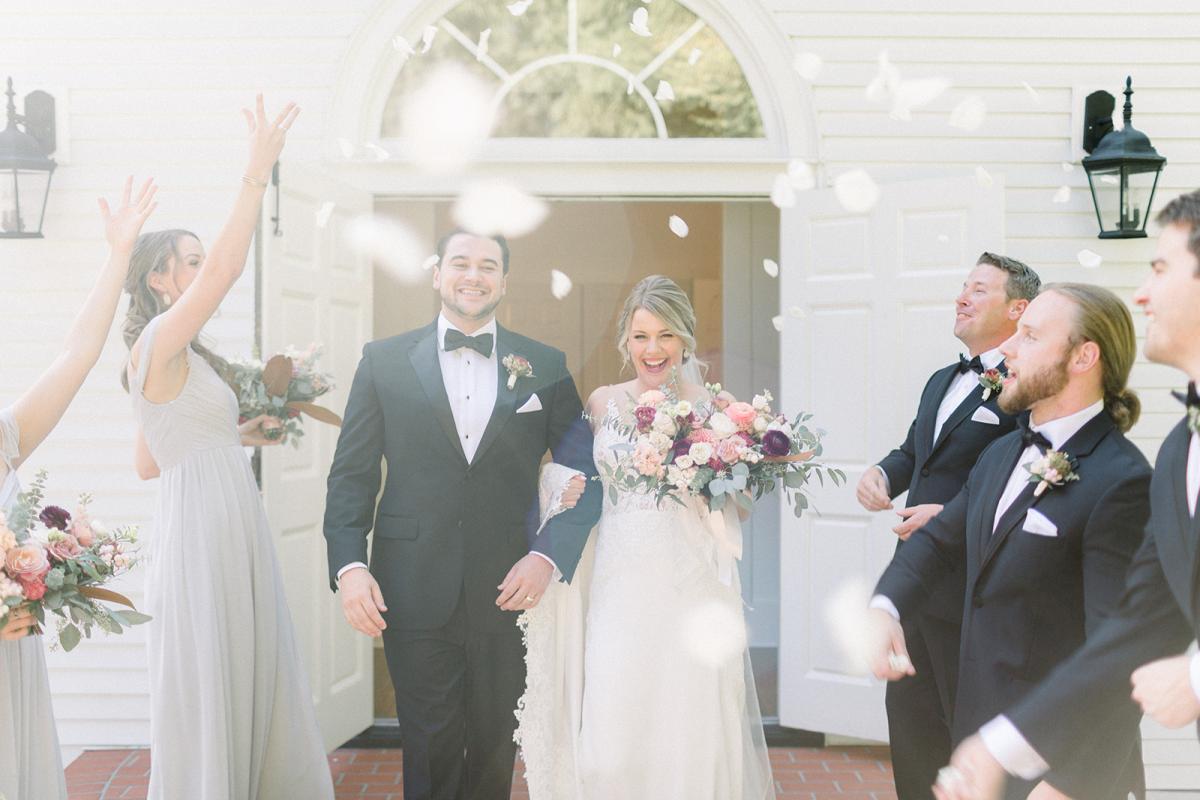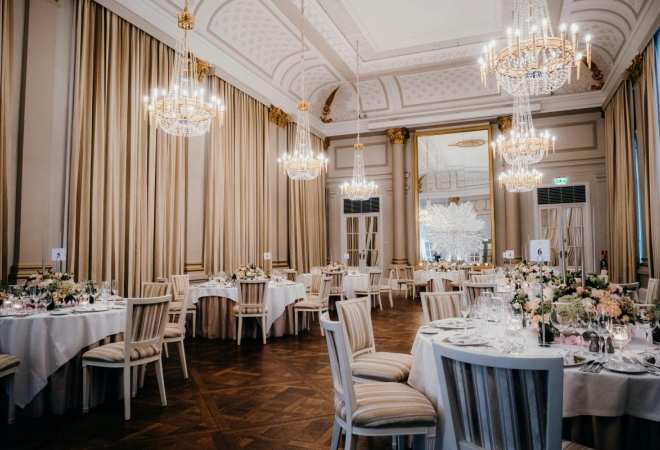Overall, it is helpful to sit down as a couple and later with your officiant to brainstorm what is most important and meaningful to you. What do you want your MARRIAGE to be about, and how do you want to represent that, along with your stories leading up to now?
There are tons of traditional things you could do, but when it comes down to it, this piece of your day is SO unique to you, your stories and your relationship with each other and your people. It’s the most important part, in our opinion, because it's a representation of what is launching you into your life together! It’s the real meaning behind the celebration.
It doesn't have to look a certain way or be a certain length (although we recommend around 30 minutes for the sake of the guests and the flow of the rest of the celebration). Once you have discussed together and with your officiant to solidify what you want to do, let's talk so we can create an outline for everyone involved and make sure we have what we need to make it happen.
This is something we especially care about, so please don't hesitate to reach out to talk through any of this in more detail! To help you get started, here are a few things that you could think about as you brainstorm. We also have put these in the order of how ceremonies generally flow. However, anything goes for your day! There are no rules!
Some of these ideas or traditions may resonate more with you or could apply to a religious or non-religious ceremony. Feel free to run with it and make it your own!
Most importantly—have fun!
-Krissy, Chad and the SBS Team
1. Music
Be sure to think about music for the following items that are meaningful to you.
-
Prelude (usually 10-15 songs on repeat while guests are seated, starting about 30 minutes prior to the ceremony or when first guests arrive and could be similar to dismissal or cocktail hour music)
- Processional (walking in) of grandparents (if not pre-seated), parents, bridal party (bridesmaids, groomsmen, ring bearer(s)/flower girl(s))
- Bridal procession (bride walking down the aisle)
- Ceremony (background for readings, unity symbol, prayer, etc.)
- Recessional (walking out) of bridal party and parents/grandparents
- Dismissal of guests (usually 10-15 songs on repeat and could be similar or the same as prelude or cocktail hour music)
*We will need to talk to your sound tech or musicians to make sure songs can be played from a phone, sheet music is purchased, etc.
2. Programs
This could take shape in so many ways or not at all! Programs can be passed out by a friend or family member, and they generally have the order of the ceremony on it so that guests know what to expect. They generally add a level of formality. They may also be a way to introduce your bridal party, parents, grandparents and even your story! They sometimes also include your updated address if you are moving to a new place together after the wedding.
3. A Token of Thanks or Celebration
To help start the festivities and, depending on your location, many couples choose to have a drink station serving champagne, wine, lemonade, or water! If you are concerned about the weather or have a date that has the possibility for hot, cool or rainy forecasts, pass out clear umbrellas, vintage paper fans, blankets, hand warmers, etc. You can also have guests (at least at seats nearest the aisle) take a small bag of petals or bubbles to hold on to with instructions to throw in the air as you are pronounced husband and wife or as you exit the venue.

4. Guest Seating
Do you want ushers to seat people on a bride's side (left) and a groom's side (right), depending on who they know? Remember that there may be more guests that know one side or the other so this may cause sides to look uneven, but it can be a fun tradition nonetheless. Many couples have a sign that says a cute phrase about how we are all family now, so they can choose their own seat. You might not need ushers to walk every person in, unless they are alone or need assistance, but simply direct guests in the direction of open seating.
5. Processing of Family & Bridal Party
Related to the music, think about how you want your family and bridal party to process and recess.
- Do you want your grandparents escorted in? If so, by whom? It could be an usher, family member, or the groom himself!
- Who will walk the bride’s mom down the aisle to be seated since father of the bride will most likely be escorting the bride? It could be a sibling, an usher or other family member.
- How do you want the bridal party walking in? In pairs? All men from one side while all girls come in alone down the aisle? How do you want them to stand? How do you want them to walk out? With a dance, sunglasses, line up at end to form a tunnel while you come back in and kiss or have them throw petals for a cute photo op? Note that the order will start with the couple or bridesmaid that will stand at the end of your line finishing up with the maid of honor/best man.
6.Giving of the Bride
Traditionally, the father or male guardian of the bride will escort the bride down the aisle. Once they arrive at the end of the aisle, the groom will generally come and meet the bride and father. The officiant will often ask, “Who gives this woman to be married to this man?". The father or both parents will say something like, “Her mother and I.” or “We do.” Following this statement, the father will hug or kiss the bride (and sometimes pull back her veil if it covers her face) and pass the her hand to the groom, who he may also shake hands with or give a hug. This signifies that the father is now passing on his daughter to her husband to care for and approves of the union.
7. Encouragement/Sermon
Generally, the officiant will give a short form of encouragement or statement on marriage/your stories/life to you and the guests.
8. Prayer
Often found at religiously affiliated ceremonies. Couples take time to pray quietly with each other, with a pastor or with parents/family.
9. Hymn, Traditional Song, Symbolic or Worship Music
This is generally found at more religious ceremonies, but it could be a song or hymn that is important to you or a reminder or tribute of a person in your family that is still with us or has passed. It could be played as guests are seated, as you do a unity representation, or sung together with all of your guests. It could be live or played on a sound track.
10. Readings
These include bible passages, meaningful quotes, stories or writings between you, something written by someone else (could be read by friends/family, officiant, or either of you).

11. Unity representation and other symbolism (ask us to expound on any of these. It’s obviously our favorite!)
- Candle: This usually includes one large candle with two smaller candles that are lit by each of your mothers or yourselves…Then, take the two candles and light the large one together.
- Tree/plant: Pour soil from each of your homes into the pot and water it…then plant at your home or place in your house.
- Sand pouring: You each pour separate sand into one container.
- Three strands ceremony: This involves three cords attached to a board with a phrase or your names as a representation of you weaving your life together as one or with God, etc.
- Value symbols: Choose items to have in your home representing the most important things you feel your marriage should be about (hospitality, friendship, forgiveness, family, hard work, love, etc.) and have people in your life that represent these values well present the item and read a little something about why this is a value for your marriage and home. Chad and I did something similar for our wedding and LOVED how this keeps us accountable and intentional about what we wanted our life to be about.
- Foot washing ceremony: Wash each other's feet as a symbol of serving and loving each other as a team.
- Time capsule box: Create or buy a small wooden box that holds letters you write to each other, a bottle of wine, etc. to open on your 1st, 5th, 10th anniversary. Place these items in the box together and share something about this.
- Mission or vision statement: Similar to the value symbols and very similar to many businesses or organizations, create one sentence or phrase (or several) that serves as your overarching statement for what your marriage and family are about. This is something that you can always return to as seasons change and decisions need to be made. It will help you remember who you are as a couple and what you want to be in each phase of life...in what you do, how you act, what your family/kids are about, what you are involved in, the people you interact with, etc.
- Share your memories or story: This is something that could be done by the officiant, several family members or by you both in person or through a video! There are tons of creative ways to do this. Not everyone may know how you met, what you are up to now, how you fell in love or even stories of what led you to be who you are today.
- Symbolic decoration: This is something we can discuss including in the style board! Some couples, both religiously and non-religiously affiliated, will include items such as signage, banners, an arbor, or chuppah (similar to an arch or arbor and a traditional Jewish symbol of hospitality that covers the top of you but has all the sides open). Chad and I included this even though we aren’t Jewish! We had florals arranged on it and had our officiant describe that this was a symbol of how we wanted to have our home to be...open to others and always welcoming. You could also have flowers/greenery added to the atmosphere to make the space more inviting. It could also be a particular plant, cross, picture, live painting or other item that represents or captures something or someone that becomes part of your celebration design or is reused at the reception or in your home.
12. Vows
This is pretty much a staple (your officiant will probably make you do this)! You can write them yourself in the form of a letter/poem/statement, memorize or read them from a script, or simply recite the traditional ones that your officiant most likely has.
13. Exchanging of Rings
I hope your best man is reliable enough to hold on to these. Usually, the ring bearer holds a pillow with symbolic rings or nothing at all. The best man or a trusted bridal party member will have these in a pocket until the officiant asks for them, so you can place them on each other’s ring finger.
14. Kiss
Not much explanation needed!
15. Pronouncement of Couple
Officiant officially announces you as Mr. & Mrs.!!! Let him/her know how you’d like to be introduced (i.e. Mr. & Mrs. Ben & Gina Bourgoin, Mr. & Mrs. Bourgoin, Mr. & Mrs. Ben Bourgoin).
16. Dismissal of Guests
Do you want to dismiss all your guests row by row? In my opinion, this is the best way I've seen it done. A greeting line is hard to control and trying to make it to every table at the reception can be very difficult to accomplish and stressful during a time you want to most enjoy.
You also can simply have the officiant announce instructions for guests to make their way to cocktail hour/reception and have guests dismiss themselves or have ushers come up to dismiss them.
This time may also include instructions for family to remain for photos or a send-off. You can also hand out guest favors or tokens (as described above) during this time.

are you a bride-to-be?
We'd love to plan with you on weddingday-online.com. Let's get started!
are you a wedding extraordinaire?
Join WeddingDay Magazine in inspiring brides by partnering with us! See how here.








Join the conversation
Log in or register to post comments